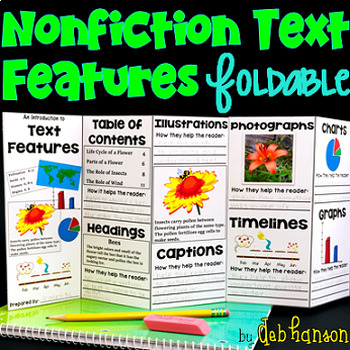Nonfiction Text Features Foldable Activity in Print and Digital
- PDF
- Google Apps™
- Easel Activity

What educators are saying
Also included in
- Understanding text features and how authors use them in nonfiction texts is critical for reading comprehension. This nonfiction text features bundle has everything you need to keep your students engaged as they learn about 23 types of nonfiction text features. The activities in this bundle make learPrice $14.00Original Price $30.50Save $16.50
Learning Objective
Students write short sentences explaining how each text feature can help a reader comprehend a nonfiction book.
Description
Understanding text features and how authors use them in nonfiction texts is critical for reading comprehension. This engaging study guide resource includes a foldable activity related to nonfiction text features. Students will identify text features and explain how each is used. When students complete the activity, they have the perfect reference tool that they can refer back to throughout the school year!
Many common text features are featured, including table of contents, index, glossary, title page, heading, subheading, diagram, labels, caption, cutaway, close-up, map, timeline, photograph, illustration, hyperlink, charts, graphs, and bold words.
WHAT YOU WILL GET:
- ACTIVITY 1: Introduction to Text Features Study Guide (Printable)- I use this as an introduction activity. I give each student a packet, and I place my own copy under the doc camera. We go through each text feature presented and write a sentence that explains how that text feature helps the reader comprehend the book. (A key is included for teacher guidance, if desired.) Then, we follow the student-friendly directions to assemble the accordion-style book, and tape it into our interactive notebooks.
- ACTIVITY 2- Book Identification Study Guide (Printable)- I use this as a follow-up activity. It is set up like a nonfiction text feature scavenger hunt, but it provides picture supports. Students look for the given text features in their own nonfiction book. When they find a text feature, they indicate the page number and write a brief summary below the page number.
- Google Slides Activity- This digital version combines the two activities. Each Google Slide contains two text features. Below each text feature and image, students write an explanation of how it helps a reader. Near the bottom of each slide, there is a text box where students can identify the title of a book and the page number where they found the given text feature.
CHECK THE PREVIEW to study each version!
Detailed instructions (with photos!!) are included for your students to follow. It also includes a teacher instruction page that lists the exact materials you need to prepare for this craftivity.
CHECK OUT WHAT TEACHERS LIKE YOU HAVE TO SAY:
- Michelle D. said, "This was a great resource that I used with my students. They were able to have this as a helper in their desks during our text features unit. I was also able to use this in our small groups where students could dive deeper into each feature and relate it to the book we were reading."
- Kristin C. said, "I used this resource to introduce various nonfiction text features. Then the students used it as a reference to complete center work and follow up activities. We've been actively using it as a resource for about 2 weeks. It's awesome!"
- Hayley L. said, "Okay I'm not going to lie--text features are such a boring lesson even though it's essential but THIS was perfect for my kids!! They loved building it and filling it in together. AND they glued them into their journals so they have quick access to it at all times. They think it is so fun when their foldable pops out at them when they use it. Very engaging and made text features so much easier to teach!"
- Kathryn H. said, "I use this resource every year for solidification of nonfiction text features. It's fun, and my partner teachers have loved it, also. My students benefit from taking notes and reviewing each text feature we've studied. Great resource! "
Feel free to check out my other nonfiction text feature resources:
Nonfiction Text Features Craftivity
Nonfiction Text Feature PowerPoint (with a matching companion handout!)
Nonfiction Text Features Memory Game (23 matches!)
Nonfiction Text Features Assessment (22 multiple choice questions!)
Copyright by Deb Hanson
This item is a paid digital download from my TpT store
www.teacherspayteachers.com/Store/Deb-Hanson
This product is to be used by the original downloader only. Copying for more than one teacher is prohibited. This item is also bound by copyright laws. Redistributing, editing, selling, or posting this item (or any part thereof) on an Internet site that is not password protected are all strictly prohibited without first gaining permission from the author. Violations are subject to the penalties of the Digital Millennium Copyright Act. Please contact me if you wish to be granted special permissions!







